
Summary
Paratrygon aiereba (also known as discus ray, manzana ray or ceja ray) is a cartilaginous fish in the family Potamotrygonidae from the Amazon basin in South America.[2]
| Paratrygon aiereba | |
|---|---|

| |

| |
| Paratrygon aiereba from above and below. Notice its concave snout, visible lower left on upper photo and to the right on lower photo | |
| Scientific classification | |
| Domain: | Eukaryota |
| Kingdom: | Animalia |
| Phylum: | Chordata |
| Class: | Chondrichthyes |
| Subclass: | Elasmobranchii |
| Superorder: | Batoidea |
| Order: | Myliobatiformes |
| Family: | Potamotrygonidae |
| Genus: | Paratrygon |
| Species: | P. aiereba
|
| Binomial name | |
| Paratrygon aiereba (Müller & Henle, 1841)
| |
Appearance edit
This freshwater ray has small eyes and a disc shaped roughly like a lily pad (the snout is slightly concave).[3] It is brownish above with a dark vermiculated or reticulated pattern.[3] It reaches up to 1.6 m (5.2 ft) in disc width and 110 kg (240 lb) in weight, making it one of the largest species in the family.[3] There are unconfirmed claims of much larger individuals, but these are considered highly questionable.[4] Most individuals do not surpass a disc width of 1.3 m (4.3 ft).[3] Males reach maturity at a disc width of about 60 cm (2.0 ft) and females at about 72 cm (2.4 ft).
Behavior edit
It mainly feeds on fish,[5] but also take invertebrates such as insects and crustaceans,[3] and it is a top predator in its habitat.[6] Adults are found in relatively deep waters in main river channels, but move to shallower waters to feed at night. After a nine-month gestation, the female give birth to an average of two young with a disc width of about 16 cm (6.3 in). Juveniles are found in relatively shallow waters at sandy beaches and in creeks.[3]
References edit
- ^ Góes de Araújo, M.L.; Rincón, G. (2018). "Paratrygon aiereba". IUCN Red List of Threatened Species. 2018: e.T161588A124329685. doi:10.2305/IUCN.UK.2009-2.RLTS.T161588A124329685.en. Retrieved 12 November 2021.
- ^ Loboda TS, Lasso CA, Rosa RS, Carvalho MR (11 June 2021). "Two new species of freshwater stingrays of the genus Paratrygon (Chondrichthyes: Potamotrygonidae) from the Orinoco basin, with comments on the taxonomy of Paratrygon aiereba". Neotropical Ichthyology. 19 (2). doi:10.1590/1982-0224-2020-0083. S2CID 236301627.
- ^ a b c d e f Last; White; de Carvalho; Séret; Stehmann; Naylor, eds. (2016). Rays of the World. CSIRO. p. 626. ISBN 9780643109148.
- ^ "Paratrygon aiereba". fishing-worldrecords.com. Retrieved 25 October 2017.
- ^ Reynolds; Hornbrook; Stettner; Terrell (2017). Smith; Warmolts; Thoney; Hueter; Murray; Ezcurra (eds.). Husbandry of freshwater stingrays. Special Publication of the Ohio Biological Survey. pp. 99–112. ISBN 978-0-86727-166-9.
{{cite book}}:|work=ignored (help) - ^ Rosa, R.S.; Charvet-Almeida, P.; Quijada, C.C.D. (2010). "Biology of the South American Potamotrygonid Stingrays". In Carrier, J.C.; Musick, J.A.; Heithaus, M.R. (eds.). Sharks and Their Relatives II. Marine Biology. Vol. 20100521. CRC Press. pp. 241–285. doi:10.1201/9781420080483-c5. ISBN 978-1-4200-8047-6.
{{cite book}}:|work=ignored (help)



